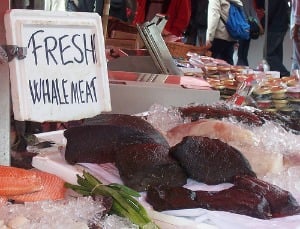When traveling to distant lands an essential item on everyone’s to-do list is to try the local gastronomy. But before we settle into a comfy booth at a restaurant it’s important to educate ourselves on the effects of ordering that exotic dish on the menu. In this post we present 6 plates that may be considered unique and unusual for visitors, but they all come with a cost environmentally that as responsible tourists we need to consider before we place our order.
Shark fin soup

Where it’s served: many Asian countries, principally China
What it is: Cartilaginous dorsal, pectoral and caudal fins of many shark species
The issue: Approximately 100 million sharks are caught and de-finned each year for shark fin soup, which raises concerns about the world’s declining shark population and debates about the inhumane treatment of catching the shark, removing the fin, and returning it to the ocean where it is unable to swim or survive.
Turtle eggs
Where it’s served: some parts of Asia and the Caribbean
What it is: Fertilized turtle eggs
The issue: Turtles take many years to reach breeding age and do not breed annually, but rather every few years, making the practice of eating the eggs an endangerment to the species (328 turtle species are considered threatened).
Puffin
Where it’s served: Iceland, Faroe Islands
What it is: Puffins are part of the bird genus Fratercula, they superficially resemble penguins because of their black and white colors, but are not related.
The issue: Although puffins are not an endangered species, their numbers have been steadily declining in recent years both in North America as well as Northern Europe due to habitat destruction and the fact that they are hunted for their eggs, feathers, and meat.
Bird’s nest soup
 Where it’s served: countries across Asia
Where it’s served: countries across Asia
What it is: The swiftlet bird’s nest dissolved in water to create a gelatinous soup. It is one of the world’s most expensive foods.
The issue: The nests are often collected before the birds have had a chance to breed causing their populations to plummet.
Bushmeat
Where it’s served: parts of Africa, Asia and Latin America
What it is: Meat from wild animals
The issue: Referred to specifically as the bushmeat crisis, the problem is that the meat comes from unsustainable hunting, most often of endangered wildlife.
Whale meat

Where it’s served: Japan, Norway, Iceland, Faroe Islands, Spain’s Basque Country, Canada, Greenland, and Korea.
What it is: The most common is meat from the Minke whale, but endangered species like the Baleen whale, Humpback, and Fin whale are also hunted.
The issue: The problem not only consists in the hunt of whales that are endangered species, but also because of the high levels of mercury and other toxins present in the meat.
If you’re interested in reading more about responsible tourism check out our other posts:
Source: IFAW



